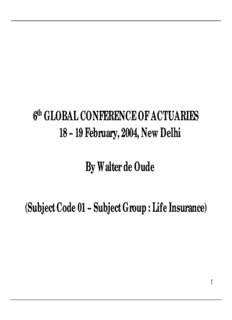
Cash Flow Pricing (GCA)_Walter de Oude.p - Actuarial Society of India PDF
Preview Cash Flow Pricing (GCA)_Walter de Oude.p - Actuarial Society of India
6th GLOBAL CONFERENCE OF ACTUARIES 18 – 19 February, 2004, New Delhi By Walter de Oude (Subject Code 01 – Subject Group : Life Insurance) 1 C a shflo w pricing techniques Cashflow Pricing Walter de Oude 5th GCA Feb 2004 Objectives Illustrate the advantages of cash flow methods over n traditional methods Give practical exa mples of how cash flow methods can n be used for pricing Outline so me useful techniques, based on the cash flow n approach, which will enable us to better understand the business that we write Page 3 The Actuarial Control Cycle initial assumptions pprrooffiitt tteesstt updating of model office assumptions actual v. monitoring expected Page 4 Traditional Methods (1) Developed before co m puters were widely available n Use tables of annuity (ä ) and assurance (A ) factors, and n x x co m mutation functions ( C , D , N , M , R , etc) x x x x x Page 5 Traditional Methods (2) Determining premiu ms involved n solving an equation like: = + + Pä SA I mPä x:n| x:n| x:n| w here n – P, S = premium, sum insured – I , m =initial, maintenance expenses Page 6 Proble ms with Traditional Methods Assu mptions are inflexible ( eg interest rate cannot be n varied over time) Difficult to allow for co mplex benefits ( eg return of n premiu ms on death) Can only allow for one decrement n (eg no allowance for profits and losses on surrenders, difficult to include rider benefits) Page 7 C a sh Flow Methods (1) M a ke use of co m puters for co mplex calculations n M o re co mplicated models are possible allowing us to n overco me these disadvantages M o re intuitive and easier to understand for non-actuaries n Page 8 C a sh Flow Methods (2) Can incorporate assu mptions about: n – surrenders and lapses 4 – riders and additional benefits 4 – valuation basis and method 4 – n ew business 4 – profitability targets 4 – cost of capital – bonuses and distribution of surplus – reinsurance Page 9 C a sh Flow Methods (3) The basic idea n – Set up a colu mn for every cash flow relevant to the policy, and so me colu m ns for intermediate calculations if required – For each colu mn, multiply the possible cash flow by the probability of that cash flow occurring to get an expected cash flow – M anipulate the cash flows to arrive at the desired result Page 10
Description: